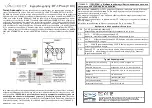
51/106
Siemens
Basic Documentation RVP360
CE1P2546en
Building Technologies
12 Function block: Boiler
2017-07-24
12.4.2 Control with 2-stage burner
For 2-position control with a 2-stage burner, the variables that can be set are the
switching differential and the minimum burner running time – the latter now apply-
ing to both stages – plus the following variables:
The release integral (FGI) for the second stage: This is the variable generated
from the progression of temperature (T) and time (t). If the maximum limit is ex-
ceeded, the second burner stage is released and can be switched on. Prerequi-
site is that the minimum locking time for the second stage has elapsed
FGI =
t
dt
T
0
where:
T
= ( w 0.5
*
SD x ) > 0
The reset integral (RSI): This is a variable generated from the progression of
temperature and time. If the maximum limit is exceeded, the burner is locked
and shuts down
RSI =
t
dt
T
0
where:
T
= ( x w + 0.5
*
SD ) > 0
The minimum locking time for the second stage, which is the period of time on
completion of which the second stage can be switched on at the earliest
The controller compares the actual value of the flow temperature with the setpoint.
If it falls by half the switching differential (x < w 0.5
*
SD) below the setpoint, the
first burner stage is switched on. At the same time, the minimum waiting time for
the second burner stage commences and the release integral is being generated.
The controller ascertains for how long and by how much the flow temperature
remains below w 0.5
*
SD. It continuously generates the integral based on the
progression of temperature and time.
If, on completion of the minimum locking time, the flow temperature lies below
w 0.5
*
SD, and the release integral reaches the set maximum limit, the second
burner stage is released and switched on. The flow temperature rises.
If the flow temperature exceeds the setpoint by half the switching differential
(x = w + 0.5
*
SD), the second burner stage is switched off again, but remains re-
leased. The first stage continues to operate. If the flow temperature drops again,
the second stage is switched on again at x < w 0.5
*
SD. Now, the setpoint is
maintained with the help of the second burner stage.
If, however, the flow temperature continues to rise (x > w + 0.5
*
SD), the controller
starts generating the reset integral. It determines for how long and to what extent
the flow temperature remains above the setpoint by half the switching differential. It
continuously generates the reset integral based on the progression of temperature
and time. When the reset integral reaches the set maximum limit, the second burn-
er stage is locked and the first stage is shut down.
The minimum locking time and calculation of the release limit at x < w 0.5
*
SD
are started when the switch-on command for the first burner stage is given.
Due to the time-temperature integral, it is not only the duration of the deviation that
is considered but also its extent when deciding whether the second stage shall be
released or locked.
Setting parameters
Control process
















































